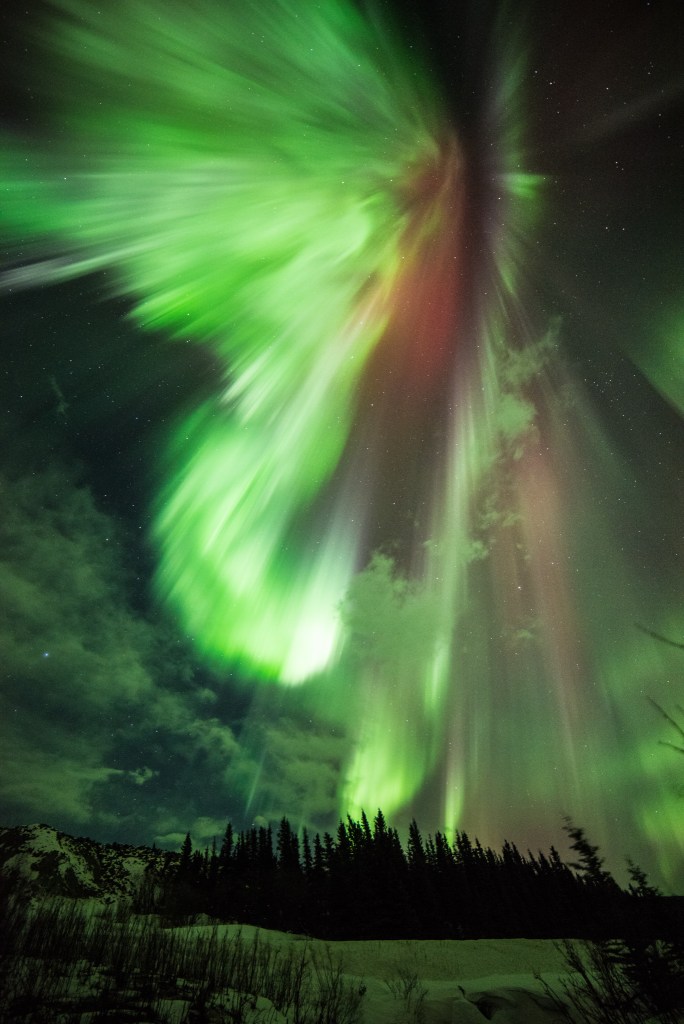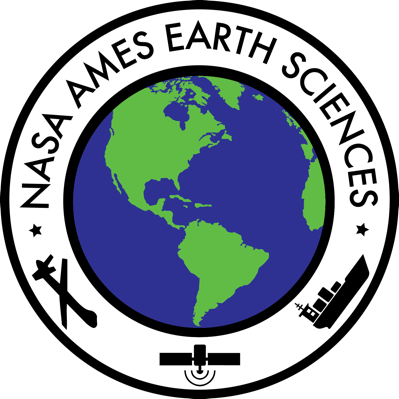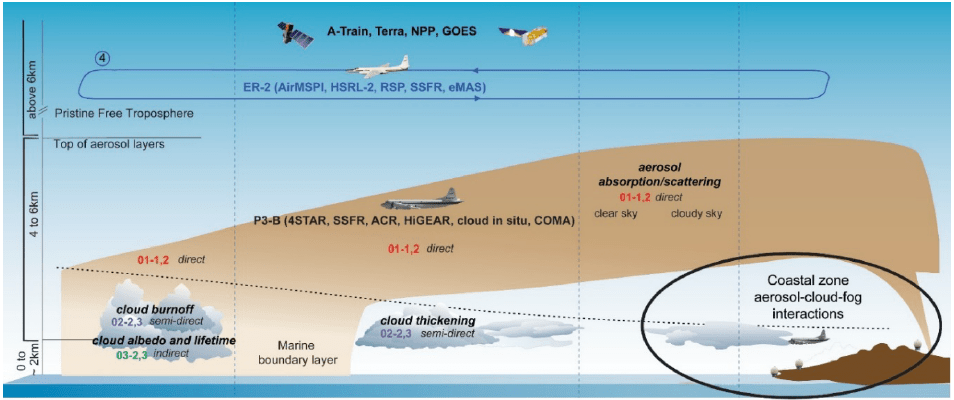Significant announcements:
22nd March 2020
- ORACLES (ObseRvations of Aerosols above CLouds and their intEractionS) Science Team Meeting – Earth Science Project Office (ESPO) hosted the ORACLES Science Team Meeting / Southeast Atlantic Workshop last week, 12 – 14 May. 122 participants met via Webex from locations ranging from Hawaii to Israel, a 13-hour time zone span. ORACLES is a five-year Earth Venture Suborbital-2 investigation (2015-2020) with three field campaigns with science and project management leadership at Ames. The science objective of ORACLES is to study key processes that determine the climate impacts of African biomass-burning aerosols. This was the last ORACLES Science Team meeting and addressed the outstanding investigation science questions and discusses future directions. Content included results from several projects based in the southeast Atlantic Ocean: ORACLES, CLARIFY, AEROCLO-sA and LASIC. Participants connected from Europe, Africa, and the US. The meeting was originally planned for a venue at the University of Miami but was changed to remote format due to COVID19 restrictions. The agenda was very compressed to accommodate the variety of time zones, but the meeting was completed successfully and materials have been shared among participants.
Link: https://espo.nasa.gov/oracles/content/ORACLES_2020_Science_Team_Meeting - NASA Ames is still at Level 4, the highest level in the NASA Response Framework to pandemics – Major adjustments in work style, focus and schedules due to the COVID-19 distancing protocols – ESPO managed NASA airborne missions and other programs and projects at ARC are experiencing major schedule delays due to COVID-19. Ames staff are focusing on data analysis, publications/proposals/reports writing, and computer-aided design work. Staff are continuing telework and managing workflows and productivity while travel, lab work and mission-critical flight and instrument work are on hold. Several teams are now actively engaged in responding to the short-fuse Announcement of Opportunity (AO) from HQ – Rapid Response to the COVID-19 Pandemic (ROSES2020, A.28) – and other proposal preparation activities. Several submitted concepts have already received a go-ahead from HQ, for a full proposal, and first full proposals have been submitted.
Link to Rapid Response AO: https://nspires.nasaprs.com/external/solicitations/summary!init.do?solId=%7b3F3DFBFB-8FEE-F317-63FD-CB84ECA833EC%7d
15th March 2020
- ORACLES (ObseRvations of Aerosols above CLouds and their intEractionS) Science Team Meeting – Kristina Pistone, Samuel LeBlanc, Yohei Shinozuka, Stephen Broccardo, Michal Segal-Rosenheimer, Meloë Kacenelenbogen, James Podolske, Rei Ueyama and Ju-Mee Ryoo participated in the virtual ORACLES Science Team meeting on 12-14 May 2020. ORACLES is a five-year Earth Venture Suborbital-2 investigation (2015-2020) with three field campaigns with science and project management leadership at Ames. The science objective of ORACLES is to study key processes that determine the climate impacts of African biomass-burning aerosols. This is the last ORACLES Science Team meeting and addresses the outstanding investigation science questions and discusses future directions:
- NASA Ames is still at Level 4, the highest level in the NASA Response Framework to pandemics – Major adjustments in work style, focus and schedules due to the COVID-19 distancing protocols – ESPO managed NASA airborne missions and other programs and projects at ARC are experiencing major schedule delays due to COVID-19. Ames staff are focusing on data analysis, publications/proposals/reports writing, and computer-aided design work. Staff are continuing telework and managing workflows and productivity while travel, lab work and mission-critical flight and instrument work are on hold. Several teams are now actively engaged in responding to the short-fuse Announcement of Opportunity (AO) from HQ – Rapid Response to the COVID-19 Pandemic (ROSES2020, A.28) – and other proposal preparation activities. Some submitted concepts have already received a go-ahead from HQ, for a full proposal, and first full proposals are being submitted this week.
Link to Rapid Response AO: https://nspires.nasaprs.com/external/solicitations/summary!init.do?solId=%7b3F3DFBFB-8FEE-F317-63FD-CB84ECA833EC%7d - Forest Mapping and Monitoring with SAR Data – The ARSET webinar series began this week. This four-part training, with sessions on 12, 14, 19 and 21 May is being offered by Amber McCullum and Juan Torres-Perez in collaboration with Erika Podest (JPL) and Sean McCartney (GSFC). This is the first training offered by our Land Management team focused on SAR data and will highlight the advantages of SAR data, especially in cloud-prone tropical forests. This advanced webinar series will introduce participants to 1) SAR time series analysis of forest change using Google Earth Engine (GEE), 2) land cover classification with radar and optical data with GEE, 3) mapping mangroves with SAR, and 4) forest stand height estimation with SAR. Each session includes a background presentation and a hands-on guided exercise for accessing and analyzing Sentinel-1 and Landsat data. The training will be presented live in both English and Spanish and has over 1,900 participants registered globally.
Link: https://arset.gsfc.nasa.gov/land/webinars/forest-mapping-sar - USGS/NASA mission passes AFSRB – The USGS volcano monitoring sUAS gas sensing flight mission at Makushin Volcan (Amaknak Island, Alaska) using a Black Swift Technologies LLC (Boulder CO) SBIR sUAS product, with airborne operations managed at NASA Ames (Matt Fladeland), has passed its AFSRB (Airworthiness and Flight Safety Review Board) review with flying colors on May 7th, 2020. The next step will be a site visit, before the FRR (Flight Readiness Review). The Blackswift S2 was developed by Black Swift as an SBIR investment with JPL supervision, and was reconfigured to accommodate gas payloads on volcanoes and renamed during an EVS-3 preparatory flight under scientific leadership by Ames Earth Science division deputy and volcanologist Florian Schwandner while he was still at JPL, and ecologist Josh Fisher (JPL).
- Pandora is now streaming live data – A new Pandora instrument, #34 of the Pandora Project, was installed a few months ago on the roof of building N245 as part of our existing live automated atmospheric measurement instrument suite. Our Pandora instrument now has an active live stream into the international Pandora data network, called Pandonia Global Network (PNG)– both raw and processed data are available with a one-day processing lag. Pandora is a compact, modestly-priced sun/sky/lunar passive UV/Visible grating spectrometer system similar to the older and simpler NOVAC network of instruments. The Pandora initiative started in 2005 and is a NASA-ESA collaboration for Satellite validation of atmospheric gas measurements. Earth Venture Instruments (EVI) and Earth Venture Suborbitals (EVS) have made use of the Pandora instrument network for the purposes of validation and verification, including DISCOVER-AQ.
Link: https://pandora.gsfc.nasa.gov/ (Pandora project)
Link: http://pandonia.net/ (Pandonia global network, with data streams)
8th March 2020
-
ORACLES (ObseRvations of Aerosols above CLouds and their intEractionS) Science Team Meeting – Kristina Pistone, Samuel LeBlanc, Yohei Shinozuka, Stephen Broccardo, Michal Segal-Rosenheimer, Meloë Kacenelenbogen, James Podolske, Rei Ueyama and Ju-Mee Ryoo will be participating in the virtual ORACLES Science Team meeting on 12-14 May 2020. ORACLES is a five-year investigation (2015-2020) with three Intensive Observation Periods (IOP) designed to study key processes that determine the climate impacts of African biomass-burning aerosols. This will be the last ORACLES Science Team meeting. It will address the outstanding investigation science questions and lay out where more research is needed:
AEROSOL AGING AND TRANSPORT: 12 MAY, 2020
1. Do we have a consistent picture of aerosol aging during transport across the southeast Atlantic region?
2. Is our understanding of the physical and chemical properties of the aerosol consistent with the optical properties?
3. Do we have a consistent view of biomass-burning aerosol optical properties and how they change across the region?
CLOUD PROCESSES: 13 MAY, 2020
1. How does aerosol impact the transition from stratocumulus to cumulus? Is it a hastening or a delay?
2. What do we still need to know about biomass-burning aerosols, aerosol activation, and precipitation susceptibility?
3. How are aerosol-cloud interactions discriminated by aerosol-cloud vertical structure?
LARGER-SCALE MODELING & REMOTE SENSING: 14 MAY, 2020
1. How have we improved satellite retrievals for constraining large scale model outputs over the region?
2. How well do current models resolve key meteorological/cloud/aerosol properties and their interactions?
3. How representative are the measurements of multi-year means and variability?
- NASA Ames is still at Level 4, the highest level in the NASA Response Framework to pandemics – Major adjustments in work style, focus and schedules due to the COVID-19 distancing protocols – ESPO managed NASA airborne missions and other programs and projects at ARC are experiencing major schedule delays due to COVID-19. Ames staff are focusing on data analysis, publications/proposals/reports writing, and computer-aided design work. Staff are continuing telework and managing workflows and productivity while travel, lab work and mission-critical flight and instruments work are on hold. Several teams are now actively engaged in responding to the short-fuse Announcement of Opportunity (AO) from HQ – Rapid Response to the COVID-19 Pandemic (ROSES2020, A.28) – and other proposal preparation activities. Some submitted concepts have already received a go-ahead from HQ, for a full proposal.
Link to Rapid Response AO: https://nspires.nasaprs.com/external/solicitations/summary!init.do?solId=%7b3F3DFBFB-8FEE-F317-63FD-CB84ECA833EC%7d
1st March 2020
-
NASA NeMO-Net called on Citizen Scientists around the world to help map the world’s corals – thousands responded. NeMO-Net, launched on 22 April 2020 for the 50th anniversary of Earth Day, is an award-winning benthic habitat mapping citizen science virtual game environment, NASA invites the public to embark on virtual ocean research expeditions to help map coral reefs around the world to better understand these threatened ecosystems. NASA has 3D images of the ocean floor, including corals, algae and seagrass, but the data alone do not tell the whole story of what’s happening to the corals beneath the waves. NASA asks the players to virtually “dive” to the Earth’s coral reefs within NeMO-Net, to help train NASA’s Pleiades supercomputer at Ames to recognize corals from any image of the ocean floor based on coral classifications players make by hand. NeMO-Net is a product of Ved Chirayath’s group in the Ames Earth Science Division. NeMO-Net is funded by the AIST program and is available for multiple platforms.
The initial release saw almost 30,000 segments classified by almost 21,000 users, followed by an additional 12,500 on Earth Day alone by almost 4,000 users. Users are dominantly from the U.S., Canada, the U.K., Singapore, and Germany.
April 9 press release: https://www.nasa.gov/press-release/nasa-calls-on-gamers-citizen-scientists-to-help-map-world-s-corals/
April 22 Earth Day special: #EarthDayAtHome on NASA TV: https://www.nasa.gov/feature/goddard/2020/earthdayathome-with-nasa/
Link: https://www.nasa.gov/ames/las - Joint NASA/USGS Postdoctoral fellows Drs. Liz Carter and Dan Griffith presented their work to a combined NASA and USGS Headquarters audience during a virtual ‘brown-bag’ held on 21 April 2020 – More than fifty people attended, including USGS’ Senior Science Advisor Dr. Geoff Plumlee, NASA SMD’s Assistant Deputy Associate Administrator for Management Dan Woods, and NASA Earth Science Acting Division Director Sandra Cauffman. Several science program managers have subsequently reached out to Dan and Liz to learn more about their work and discuss future opportunities. The titles of their talks were Advancing Ecosystem Science with Phylogeny and Remote Sensing of Functional Diversity (Dr. Dan Griffith), and Automatic Satellite-Based Flood Detection (Dr. Liz Carter).
- Surface Biology and Geology (SBG) – a hyperspectral (VSWIR/NIR) observing system recommended in 2017 Earth Science Decadal Survey. It entered a multi-Center, JPL-led two-year pre-phase A study in late-2018 and has an anticipated launch date in 2026-2027. MEET-SBG and SISTER, a $5M 5-year science pathfinder effort, are new projects that grew out of the SBG pre-phase A study. ARC played a significant role in developing these projects and will contribute leadership and technical expertise to both.
The final Statement of Work for a Surface Biology & Geology (SBG) modeling study was submitted to NASA HQ. This is a 6-year, $2.25M effort that will build on activities conducted during the SBG pre-phase A study to advance an Observing System Simulation Experiment (OSSE) for hyperspectral observing systems. The SBG modeling study, named Modeling End-to-End Traceability to Support SBG (MEET-SBG), will continue uncertainty quantification activities used to evaluate instrument models and their performance under different atmospheric conditions for different research areas, initiate regional to global OSSE activities, and simulate expected SBG-like surface reflectance spectra from existing and emerging hyperspectral and multispectral instruments (HISUI, DESIS, PRISMA, CHIME, EnMAP, MODIS, etc.).
Dr. Weile Wang (Code SG) and Dr. Anh Nguyen (Code RD) will be participating in MEET-SBG, extending instrument model and orbital designs to SBG Phase A and Phase B instrument designs and providing orbital dynamics inputs for the OSSE development in the first year.




























